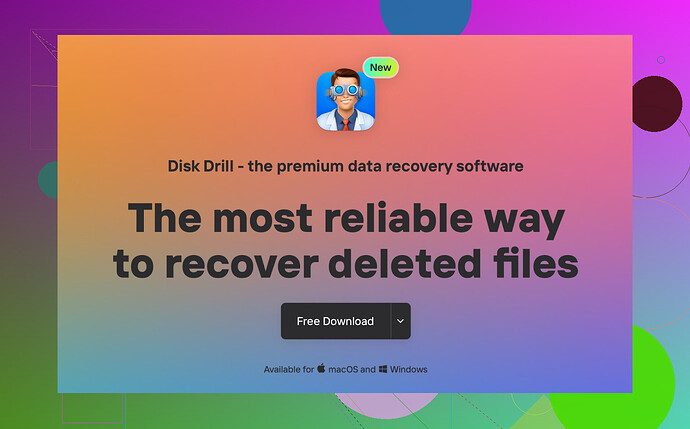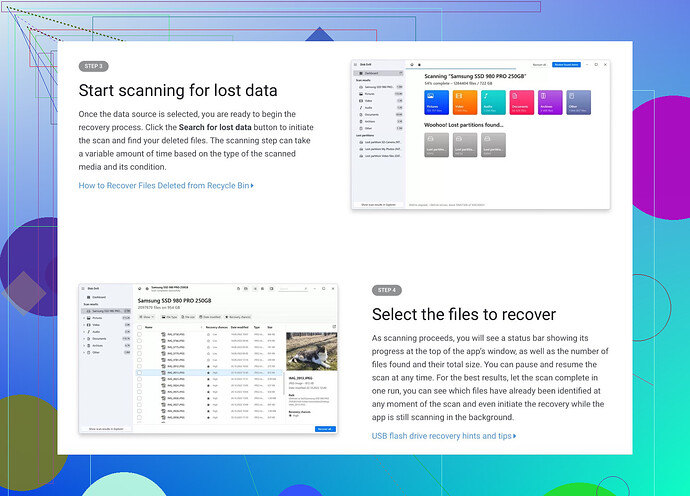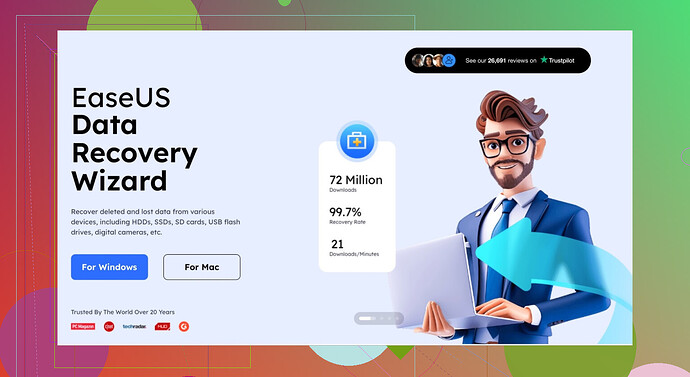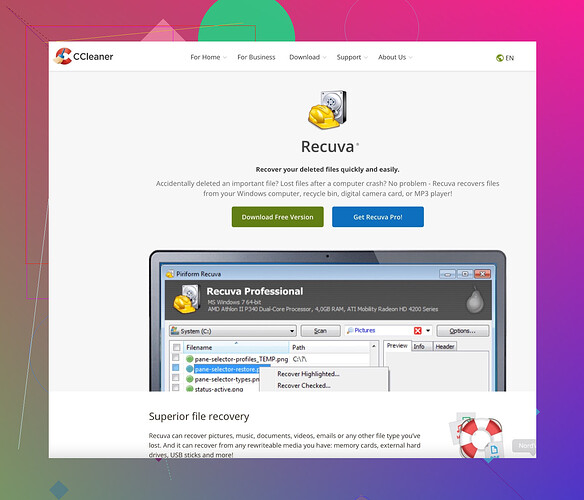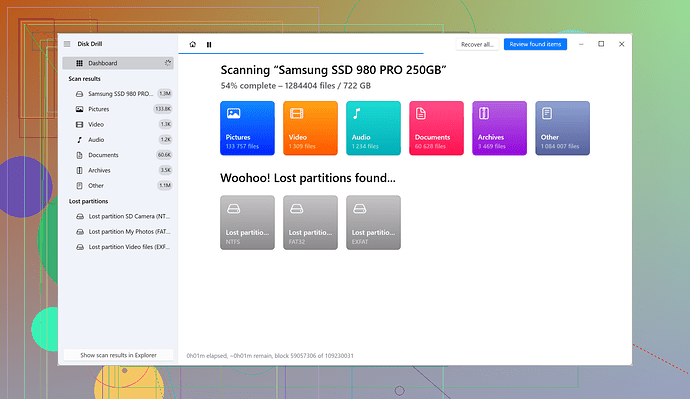I accidentally deleted important files from my Mac, and I need reliable recovery software to restore them. Could someone recommend the best data recovery tools for Mac that are effective and easy to use? I’m looking for suggestions to help recover these crucial files.
Top Data Recovery Solutions for Mac & Windows: Free & Paid Options
Introduction
Data loss can strike unexpectedly—accidental deletions, system crashes, or formatting mishaps can all lead to lost files. Fortunately, there are recovery tools, both free and paid, that can help retrieve your valuable data. Let’s explore some of the best options available for Mac and Windows users tailored to various needs.
1. Disk Drill (Mac & Windows)
Why Choose Disk Drill:
Disk Drill is like a personal assistant for lost files, guiding users through recovery with ease. Designed for beginners yet powerful for professionals, it supports over 400 file types.
Pros:
- User-friendly interface: Perfect for those new to recovery tools.
- Wide file support: Recovers documents, photos, videos, and more.
- Additional features: Shields your files with Recovery Vault for future security.
- Free version: Retrieve up to 500MB on Windows.
Cons:
- For Mac users, the free plan only offers file previews.
- Deep scans may take a while, depending on storage size.
- A paid license is required for full recovery.
Verdict:
Disk Drill is intuitive, powerful, and perfect for recovering everything from everyday files to professional projects.
Explore Disk Drill here
Community feedback on Reddit
YouTube insights: https://www.youtube.com/watch?v=IGEizr1WZ3E
2. EaseUS Data Recovery Wizard (Mac & Windows)
Why Choose EaseUS:
EaseUS simplifies data recovery into a quick, three-step process. Its AI-powered scanning ensures a deep recovery experience tailored to your needs.
Pros:
- Ease of use: Recover lost files with minimal effort.
- Smart scanning: AI-driven technology to locate deep-buried files.
- Free recovery: Restore up to 2GB of data for free.
- Advanced capabilities: Recovery for lost partitions and RAW files.
Cons:
- Limited free recovery may not suffice for larger files.
- Deep scan functionality is time-intensive.
- Advanced recovery options require purchasing the full version.
Verdict:
A dependable choice for modern users, EaseUS simplifies complex recovery while delivering excellent results.
Checkout user reviews on Reddit.
3. Recuva (Windows Only)
Why Choose Recuva:
Recuva stands out as a lightweight yet effective tool. Whether you deleted a critical file seconds ago or months ago, its recovery capabilities remain impressive.
Pros:
- Totally free: Unlimited recovery of files.
- Portable and fast: Can run from external drives without installation.
- User simplicity: Designed with accessibility in mind.
Cons:
- Windows-exclusive—there’s no version for Mac users.
- Lacks the extensive, advanced features competitors provide.
- May have issues retrieving heavily corrupted files.
Verdict:
For straightforward file recovery on Windows, Recuva is a stellar choice without any cost.
Join discussions on Reddit.
4. Stellar Data Recovery (Mac & Windows)
Why Choose Stellar:
Stellar shines through its multi-faceted recovery abilities, catering to photos, videos, emails, and more.
Pros:
- Handles recovery for diverse file types seamlessly.
- Works across numerous storage devices.
- Free plan available for up to 1GB file restoration.
Cons:
- File size limits on the free plan.
- Some scans may feel sluggish.
- Unlocking advanced tools costs extra.
Verdict:
An unbeatable option when you need robust scanning and professional-grade file repair.
5. TestDisk & PhotoRec (Mac & Windows)
Why Choose TestDisk & PhotoRec:
For tech-savvy individuals, these open-source tools provide unparalleled customization to recover files or repair lost partitions.
Pros:
- Totally free with no hidden charges.
- Exceptional at data and partition recovery.
- Compatible across multiple operating systems.
Cons:
- Exclusively command-line driven—no graphical interface.
- Not suitable for users unfamiliar with terminal commands.
Verdict:
A top-tier choice for seasoned users who confidently navigate open-source systems.
6. R-Studio (Mac & Windows)
Why Choose R-Studio:
A go-to tool in professional environments, R-Studio offers intricate recovery options, tackling even the most complex data disasters.
Pros:
- Reliable RAID recovery capabilities.
- Works seamlessly over networks.
- Extensive file system support.
Cons:
- Overwhelming for non-technical users.
- Requires purchase for meaningful access—no free version.
Verdict:
Unbelievably powerful, but best left to seasoned professionals who can navigate its complexities.
7. Wondershare Recoverit (Mac & Windows)
Why Choose Recoverit:
Recoverit earns its name by being engineered for simplicity with a focus on specialized recovery, such as damaged video repairs.
Pros:
- Exceptionally beginner-friendly interface.
- Compatible with over a thousand file formats.
- Unique multimedia restoration tools.
Cons:
- 500MB restriction in the free tier.
- Extended scans may test your patience.
Verdict:
Fantastic for those getting started or multimedia users needing specialized solutions.
8. Ontrack EasyRecovery (Mac & Windows)
Why Choose Ontrack:
Frequently cited by professionals, Ontrack’s suite of tools is robust, reliable, and invaluable for extreme recovery scenarios.
Pros:
- Supports email and RAID recovery.
- Allows up to 1GB of free retrieval.
- Vastly trusted within data recovery circles.
Cons:
- Some free-tier restrictions (e.g., 25MB per file).
- Premium features come at a steep cost.
Verdict:
An invaluable asset for high-stakes recovery operations.
9. Prosoft Data Rescue (Mac & Windows)
Why Choose Prosoft Data Rescue:
Known for its cloning feature, Prosoft allows users to work safely on a clone of a damaged or failing drive.
Pros:
- Expert recovery for failing drives.
- Perfected for Mac users.
Cons:
- Users pay per recovery attempt.
- Absence of lifetime licensing options.
Verdict:
Tailored for Mac enthusiasts dealing with intensive recovery needs.
10. MiniTool Power Data Recovery (Windows Only)
Why Choose MiniTool:
This pocket-sized solution packs enough power for basic file recovery tasks without unnecessary fuss.
Pros:
- Simple to operate.
- Free up to 1GB of data recovery.
Cons:
- Exclusively for Windows users.
- Limited utility for advanced recovery cases.
Verdict:
An easy, effective solution for Windows users with modest recovery requirements.
Closing Tips: Best Options by Category
- For Beginners: Disk Drill, EaseUS, Recoverit.
- Best Free Choices: Recuva (Windows), TestDisk (Mac & Windows).
- For Experts: R-Studio, Prosoft, Ontrack.
- Video Recovery: Disk Drill, Recoverit.
For minor losses, start with free tools. For serious data issues, a paid solution may be your best bet.
Ok, real talk, choosing the ‘best’ Mac data recovery software is like picking the perfect Netflix show—depends on your vibe and what you’re dealing with. BUT, if you accidentally deleted files and want something reliable, Disk Drill is honestly top-tier. It has a simple interface, great for both noobs and techy folks, plus it supports a crazy number of file types (400+). However, heads up, the Mac version’s free tier kind of plays you—it teases file previews but won’t let you actually recover without the paid plan. Still, its Recovery Vault is a cool feature that protects files going forward. Definitely a win if you’re serious about file recovery.
If you’re not feeling Disk Drill, maybe look into EaseUS too. Super straightforward with a free tier to recover up to 2GB, but beyond that, you’ll need to pay. The downside? Its deep scans can take ages. Stellar Data Recovery is also solid, but the free plan caps at just 1GB, which might not be enough depending on your situation. Oh, and for the nerdy folks out there, TestDisk is free and powerful but only if you’re cool with the command-line interface.
That said, disk recovery isn’t magic. If the data’s been overwritten, even the best tools can’t help. Honestly, I’d put my money on Disk Drill first—it’s got a good balance of power and usability for most people. Just don’t expect miracles if it’s been weeks since deletion.
I mean, it sounds like Disk Drill might be your MVP here. Yeah, @mikeappsreviewer and @kakeru already hyped it up—and for good reason—this thing’s got the chops for recovering most file types (400+ is wild). Plus, it holds your hand through the process with its user-friendly interface. BUT, and this is a hefty but, if you’re on Mac, the ‘free’ version is more like a demo—it lets you see the files you can recover, but you’ll have to open that wallet to actually get them back. Annoying, but honestly worth it because the paid plan works like a charm.
Now, if that paywall rubs you the wrong way, EaseUS is a decent backup option. It might lack the polish of Disk Drill, but hey, you get 2GB of data for free! Just be warned—those deep scans can feel like watching paint dry.
Personally, I wouldn’t mess with stuff like TestDisk or PhotoRec unless you’re a masochist who enjoys typing commands into a terminal. They’re free and effective, sure, but about as user-friendly as a tax form. If you’re already stressed about your lost files, skip that headache.
Here’s the thing though: no software is pulling deleted data out of thin air. If you’ve already started downloading or moving files around since the delete, there’s a risk your old files got overwritten. If not, you’ve got a solid shot. My two cents: get Disk Drill, pay for the premium plan, recover your files, and maybe invest in a backup system to avoid this spiral again. Do I sound like your IT dad now? Cool.
Kinda funny to see Recuva recommended in a list of the best Mac data recovery software… since, you know, it’s a Windows-only too🤷♂️
Anyway, just tossing in my two cents here, my top 3 for Mac would go:
- Disk Drill, 2) R-Studio, 3) TestDisk/PhotoRec.
I low-key agree with @Nachtschatten about the masochist nature of using TestDisk. Terminal-only interface, no previews. it’s not exactly a relaxing weekend project. But here’s the thing -it works. I’ve used it to recover RAW photo files, MP4 videos, CorelDRAW projects, you name it. Sure, the filenames and folder structure are toast, but for a totally free open-source tool? Solid in my book.
R-Studio is what I reach for when I’m dealing with something complex, like RAID setups or half-dead drives. Definitely more user-friendly than TestDisk, but still geared toward folks who know their way around a file system.
And if you want pure usability (click one big button and let the tool do its thing, which it does reay good) Disk Drill takes the cake. The UI actually makes you feel like you know what you’re doing, even if you don’t ![]() Bonus points for Recovery Vault; it saved me once after I stupidly deleted some files.
Bonus points for Recovery Vault; it saved me once after I stupidly deleted some files.
I would say all of these tools are effective, it just depends on what you need in terms of UI, and what you’re willing/unwilling to spend. But personally, I choose Disk Drill because under the hood it’s got some seriously powerful algorithms (maybe the best on the market), and it’s all wrapped in a simple, easy-to-use interface.
Hey @techtraveller, From personal experience, I can speak about Stellar and Ontrack. Both were super easy to use and felt desent, but unfortunately… neither found what I was actually looking for ![]()
The scans ran fine, and they pulled up tons of stuff, but it was all random files I didn’t care about. Not a single one of the things I needed showed up in the results. So not sure I can fully recommend them based on that.
Anyway, after that little scare, I finally did what I should’ve done years ago: set up Time Machine. Plugged in a spare drive, turned it on, and now I feel like I’ve unlocked some secret cheat code. I swear, Time Machine might be the actual best Mac data recovery tool there is.
I know it’s probably not what you need right now, but if you’re reading this and still haven’t enabled it… do it. You’ll never run into this situation again.
@Gina that tracks. Might be a surprise to some folks, but Ontrack and Stellar are basically the same tool under the hood - just rebranded. Interface tweaks here and there, but same scanning engine, same recovery results (or in your case lack of them ![]() ).
).
So if one didn’t find your files, the other probably wouldn’t either. Not your fault, they just don’t go deep enough for some cases.
Hey @techtraveller, just wanted to jump in and recommend EaseUS and Disk Drill. Easy to use and actually pretty powerful under the hood. Out of the two, I’d say Disk Drill has a bit of an edge in my experience, especially when it comes to scanning depth and file previews (their great here).
The catch is tho on Mac, neither of them really let you recover much without a paid license. You can scan, preview, but to save anything you’ll need a licence.
Unfortunately, there just aren’t a lot of truly free data recovery tools for macOS. Windows users get way more options in that department.
I do remember using Lazesoft Mac Data Recovery yeeeears back - it was totally free and kinda clunky, but it worked. Went looking for it recently and seems like it’s been abandoned.
Of course, as others already mentioned, there’s always TestDisk/PhotoRec. Still free, still ugly😅 But I chose Disk Drill over anything.
